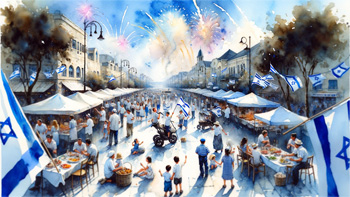 Yom Ha'atzmaut: Israel's Independence Day
Yom Ha'atzmaut: Israel's Independence Day


Yom Ha'atzmaut, also known as Israel Independence Day, is a significant national holiday in Israel, celebrated annually with great fervor and joy. This day marks the declaration of independence of the State of Israel in 1948, a landmark event in Jewish history. Yom Ha'atzmaut is not just a day of national pride; it embodies the fulfillment of a centuries-old dream for a Jewish homeland. This article delves into the origins, traditions, and contemporary celebrations of Yom Ha'atzmaut, offering insights into its importance for both Israelis and Jewish communities worldwide.
The Historical Significance of Yom Ha'atzmaut
The roots of Yom Ha'atzmaut are deeply entrenched in the long-standing Jewish aspiration for a sovereign state. After enduring millennia of exile and persecution, the Jewish dream of returning to their ancestral homeland began to materialize in the late 19th century with the rise of Zionism. The Balfour Declaration of 1917 and subsequent events laid the groundwork for the eventual establishment of Israel. On May 14, 1948, David Ben-Gurion, Israel's first Prime Minister, officially declared the independence of Israel, marking the realization of this age-old dream. This historical moment is commemorated every year on Yom Ha'atzmaut, reflecting on the struggles and triumphs of the Jewish people.
Yom Ha'atzmaut Celebrations
Celebrations of Yom Ha'atzmaut are vibrant and diverse, reflecting the rich tapestry of Israeli culture. The day is marked with a range of activities, from official ceremonies to street parties. One of the most iconic events is the lighting of twelve torches at Mount Herzl in Jerusalem, symbolizing the twelve tribes of Israel. This ceremony is attended by Israeli leaders and dignitaries and broadcasted nationwide. In cities across Israel, people take to the streets to enjoy parades, concerts, and public singing and dancing. Israeli flags are prominently displayed, and homes, streets, and public buildings are adorned with blue and white decorations, the colors of the Israeli flag.
Memorial Day to Independence Day Transition
Yom Ha'atzmaut is immediately preceded by Yom Hazikaron, Israel's Memorial Day for fallen soldiers and victims of terrorism. This juxtaposition creates a powerful emotional transition from somber remembrance to joyous celebration, reflecting the sacrifices made for the establishment and defense of the state. At sunset, as Yom Hazikaron ends, the mood shifts dramatically with the commencement of Yom Ha'atzmaut celebrations, signifying the nation's resilience and the triumph of life and independence.
Traditional and Modern Observances
Traditional observances include synagogue services where special prayers and songs are recited, thanking God for the independence of Israel. Many families host or attend barbecues, known as 'mangal' in Hebrew, which is a popular Yom Ha'atzmaut tradition. In recent years, modern observances have also included open-air concerts, beach parties, and air force flyovers. These festivities reflect the blend of traditional Jewish values with the dynamic, contemporary Israeli culture.
Yom Ha'atzmaut Worldwide
Yom Ha'atzmaut is also celebrated by Jewish communities around the world. Synagogues often hold special services, and community centers organize cultural events, showcasing Israeli music, dance, and food. These global celebrations highlight the connection and solidarity of the Jewish diaspora with Israel, reinforcing the cultural and spiritual bonds that unite Jews worldwide.
Educational Aspects of Yom Ha'atzmaut
In schools and educational institutions across Israel, Yom Ha'atzmaut serves as an opportunity to educate young generations about the history and significance of Israel's independence. Activities often include storytelling, historical reenactments, and discussions about the values of democracy and freedom. Such educational programs ensure that the story of Israel's struggle for independence and its achievements are passed on to future generations.
Reflections on Yom Ha'atzmaut
While Yom Ha'atzmaut is a day of joy, it also offers a moment for reflection on the ongoing challenges and responsibilities of nationhood. Israelis reflect on the achievements of their young nation while contemplating the future and the path towards peace and prosperity. This day reinforces the hope and commitment of Israelis and Jews worldwide to the ideals of independence, peace, and justice.
Reflecting on the significance of Yom Ha'atzmaut, it's clear that this holiday is more than just a national day of independence; it's a symbol of perseverance, hope, and unity. It's a day that not only celebrates the past but also inspires a vision for the future. As continues to grow and evolve, Yom Ha'atzmaut remains a poignant reminder of the resilience and determination of the Jewish people. It's a time to acknowledge the hardships overcome and to look forward with optimism to the challenges and opportunities that lie ahead.
The Future of Yom Ha'atzmaut
As Israel moves forward into the future, Yom Ha'atzmaut will continue to evolve, reflecting the changing face of Israeli society. It will remain a day to celebrate the achievements of the state and its people, while also serving as a platform for dialogue and understanding among the diverse communities within Israel. The integration of new traditions and the inclusion of various cultural expressions will likely enrich the celebrations, making it a dynamic and inclusive holiday for all Israelis.
Furthermore, as global dynamics shift, Yom Ha'atzmaut's role in the international community will also evolve. It will continue to be an opportunity for Israel to strengthen its ties with allies around the world, promote cultural exchange, and foster mutual understanding. As the world becomes more interconnected, the global celebration of Yom Ha'atzmaut is likely to grow, further highlighting Israel's place in the international community.
Yom Ha'atzmaut is not just a commemoration of a historical event; it's a living, breathing celebration of Israeli identity, culture, and aspirations. It’s a day that encapsulates the spirit of a nation that has risen from the trials of the past to forge a path of hope and prosperity. As Israelis and Jewish communities worldwide continue to celebrate Yom Ha'atzmaut, they carry forward the legacy of their ancestors while shaping the narrative of a modern, vibrant Israel. In doing so, they ensure that the significance of this day is not only remembered but also lived and experienced, today and for generations to come.